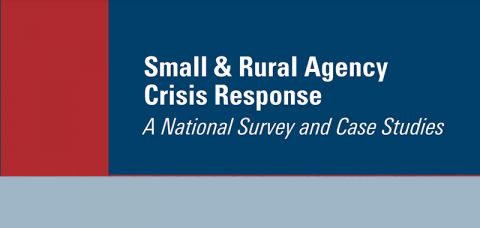Behavioral Health in Rural Communities
Despite policy efforts, the number of people in the United Stated with unmet behavioral health (mental health and substance use) needs remains high. Approximately 13.1 million people (5.2 percent of Americans) had a serious mental illness (SMI) in 2019 (up from 8.3 million or 5.2 percent in 2008).1 Substance use disorders (SUDs) are even more common with 20.4 million people above age 12 having a SUD in the past year.2 Rural communities have been disproportionately impacted by certain behavioral health issues, with opioid use disorders being a prevalent—and deadly—example.
Between 1999 and 2015, drug overdose deaths in rural communities increased at a significantly higher rate than in non-rural areas, with deaths per 100,000 rising to 17.0 in rural communities, compared to 16.2 in urban areas.3 In general, rural communities face disparate access to SUD treatment, with issues that include limited transportation, decreased geographical accessibility, and fewer overall treatment providers,4 as well as fewer treatment options.5
People living in rural areas with mental health conditions face similar barriers as individuals with SUDs. For example, community stigma, combined with the tendency to have more intimate social networks in rural areas—and therefore reduced anonymity —may result in a decreased number of people who seek out care for both mental health and substance use disorders.6,7 Similar issues also arise around access and availability, with specialty mental health services being scarce in rural communities, an estimated 65 percent of rural communities not having a single psychiatrist,8 and hospital closures in rural areas resulting in limited psychiatric hospital beds.9
Such issues call for the development of tailored approaches to expand access to behavioral health care in rural settings. Promising solutions include the use of mobile health clinics, primary care integration and telehealth expansion.10 These and other innovations specific to the rural setting are needed to respond to the unique, and urgent, behavioral health needs of these communities.
Sources
Andrilla, C. H. A., T. E. Moore, D. G. Patterson, and E. H. Larson. (2019). Geographic distribution of providers with a DEA waiver to prescribe buprenorphine for the treatment of opioid use disorder: A 5-year update. The Journal of Rural Health, 35, 108-112. https://doi.org/10.1111/jrh.12307
Andrilla, C.H.A., Patterson, D.G., Garberson, L.A., Coulthard, C., Larson, E.H. (2018). Geographic variation in the supply of selected behavioral health providers. American Journal of Preventive Medicine, 54(6, Suppl. 3), S199–S207. https://doi.org/10.1017/cts.2020.42
Blanco, C., Ali, M. M., Beswick, A., Drexler, K. Hoffman, C., Jones, C. M., Wiley, T. R. A., & Coukell, A. (2020). The American opioid epidemic in special populations: five examples. (NAM PerspectivesDiscussion Paper.) National Academy of Medicine. https://doi.org/10.31478/202010b
Grant, K., Khan, S., Dutta-Gupta, I., Counts, N., Reinert, M., & Nguyen, T. (2019). Reimagining behavioral health: A new vision for whole-family, whole-community behavioral health. Georgetown Center on Poverty and Inequality & Mental Health America. http://www.georgetownpoverty.org/wp-content/uploads/2019/07/GCPI-ESOI-MHA-Behavioral-Health-Report-online-20190729-1850.pdf
Mack, K. A., Jones, C. M., & Ballesteros, M. F. (2017). Illicit drug use, illicit drug use disorders, and drug overdose deaths in metropolitan and nonmetropolitan areas – United States. American Journal of Transplantation 17(12), 3241-3252. https://doi.org/10.1111/ajt.14555
Substance Abuse and Mental Health Services Administration. (2020). Key substance use and mental health indicators in the United States: Results from the 2019 National Survey on Drug Use and Health (HHS Publication No. PEP20-07-01-001, NSDUH Series H-55). Center for Behavioral Health Statistics and Quality, Substance Abuse and Mental Health Services Administration. https://store.samhsa.gov/sites/default/files/SAMHSA_Digital_Download/PEP20-07-01-001-PDF.pdf
Endnotes
1 Substance Abuse and Mental Health Services Administration (SAMHSA). (2020). Key substance use and mental health indicators in the United States: Results from the 2019 National Survey on Drug Use and Health (HHS Publication No. PEP20-07-01-001, NSDUH Series H-55). Center for Behavioral Health Statistics and Quality, Substance Abuse and Mental Health Services Administration. https://store.samhsa.gov/sites/default/files/SAMHSA_Digital_Download/PEP20-07-01-001-PDF.pdf
2 (SAMHSA). (2020). Key substance use and mental health indicators in the United States.
3 Mack, K. A., Jones, C. M., & Ballesteros, M. F. (2017). Illicit drug use, illicit drug use disorders, and drug overdose deaths in metropolitan and nonmetropolitan areas – United States. American Journal of Transplantation 17(12), 3241-3252. https://doi.org/10.1111/ajt.14555
4 Blanco, C., Ali, M. M., Beswick, A., Drexler, K. Hoffman, C., Jones, C. M., Wiley, T. R. A., & Coukell, A. (2020). The American opioid epidemic in special populations: five examples. (NAM PerspectivesDiscussion Paper.) National Academy of Medicine. https://doi.org/10.31478/202010b
5 Andrilla, C. H. A., T. E. Moore, D. G. Patterson, and E. H. Larson. (2019). Geographic distribution of providers with a DEA waiver to prescribe buprenorphine for the treatment of opioid use disorder: A 5-year update. The Journal of Rural Health, 35, 108-112. https://doi.org/10.1111/jrh.12307
6 Blanco et al. (2020). The American opioid epidemic in special populations: five examples.
7 Grant, K., Khan, S., Dutta-Gupta, I., Counts, N., Reinert, M., & Nguyen, T. (2019). Reimagining behavioral health: A new vision for whole-family, whole-community behavioral health. Georgetown Center on Poverty and Inequality & Mental Health America. http://www.georgetownpoverty.org/wp-content/uploads/2019/07/GCPI-ESOI-MHA-Behavioral-Health-Report-online-20190729-1850.pdf
8 Andrilla, C.H.A., Patterson, D.G., Garberson, L.A., Coulthard, C., Larson, E.H. (2018). Geographic variation in the supply of selected behavioral health providers. American Journal of Preventive Medicine, 54(6, Suppl. 3), S199–S207. https://doi.org/10.1017/cts.2020.42
9 Grant et al. (2019). Reimagining behavioral health: A new vision for whole-family, whole-community behavioral health.
10 Blanco et al. (2020). The American opioid epidemic in special populations: five examples.



